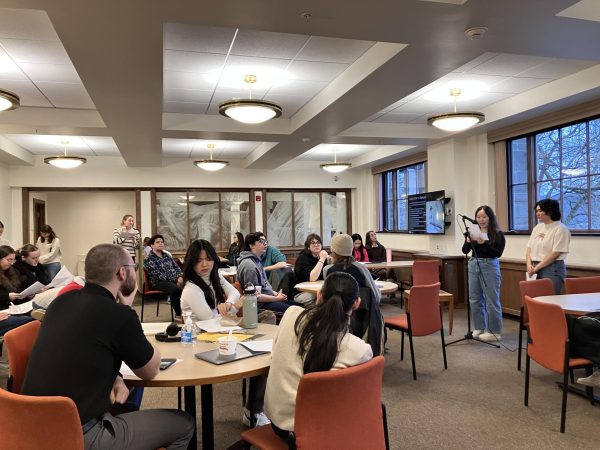Professor Joe Levy Discusses Antarctic Research at First NASC Colloquium of the Year
Colgate faculty and students gathered together on Friday, Sep. 3, in the Ho Science Center for the first NASC Colloquium of the year: The Search for Antarctica’s Future Forests: Exploring the Limits of Life in Antarctic Streams and Wetlands with Drones, presented by Assistant Professor of Geology, Joe Levy. Levy explained his work in the McMurdo Dry Valley — a polar desert in the Trans- antarctic mountains where the average air temperature falls at about negative 18 degrees Celsius.
Alongside a team of New Zealand microbiologists, Levy used drone-based hyper-spectral mapping to better understand microbial mats and hydro-climatic conditions in Antarctica. These microbial mats allow researchers to see an early warning system for local climate change in one of the Earth’s driest places as the photosynthesizing single-cell organisms, which make up the mats, have the ability to absorb carbon dioxide. Levy and his team have pioneered a new technique using drone mapping to locate these microbial mats — a huge improvement from the physical surveying which was the precedent beforehand. Locating and understanding these mats, as Levy explained, could be pivotal in the fight against climate change.
“Antarctic forests could potentially absorb 10s to 100s of gigatons of carbon if we could sequester carbon into the ground,” Levy said. “This is the equivalent to a stack of coal 1.25 miles on its side, from the [Colgate] townhouses to the Dunkin Donuts [in Hamilton].”
However, Levy made it clear that this was not a silver bullet. The consequences of sea-level rise could have devastating effects on coastal cities. In relation to these consequences, he offered, his work acts as an interesting thought experiment: how might the “greening” of Antarctica pull carbon out of the atmosphere and put some brakes on warming? Levy maintained his view that it was crucial to understand how biogeochemical systems might respond to warmer climates.
Sophomore Aphone Piang attended the colloquium and found it highly in- formative. “Professor Levy’s presentation opened my eyes to the importance of understanding how biogeochemical changes will affect warmer climates, in the fight against climate change. I think Professor Levy’s work is pivotal in possibly using microbial mats as a weapon against greenhouse gases.”
Fellow sophomore Emma Birsen shared a similar sentiment: “Professor Levy was extremely captivating in his seminar, and his research on microbial mats in Antarctica was super intriguing. These mats pull CO2 out of the atmosphere and could potentially have a huge role in reversing the effects of climate change in the future. This was news to me, and I will definitely be doing personal research on it outside of the colloquium.”
Throughout the talk, Levy used a motif: the woolly mammoths who grazed the Chenango Valley until sabertooth tigers pushed them north to a glacial wall where they were ultimately cornered and slaughtered. The world is in a perpetual state of change, as represented by the creatures who may have marched over current Colgate property tens of thousands of years ago that no longer exist. If we can better understand how these changes will manifest, perhaps we will have a better chance at minimizing human suffering from the devastating effects of climate change.
If you are interested in learning more, recordings of the NASC Colloquium lectures can be found on the Colgate Natural Sciences webpage.






